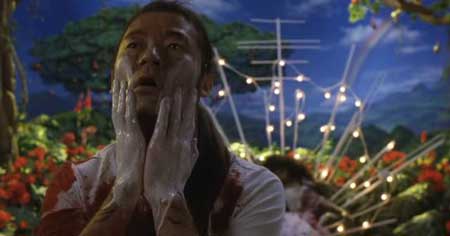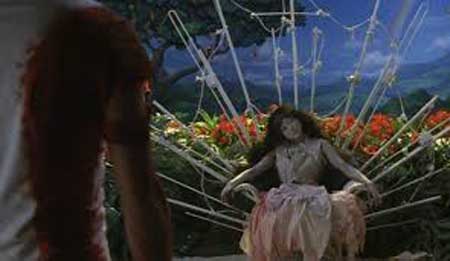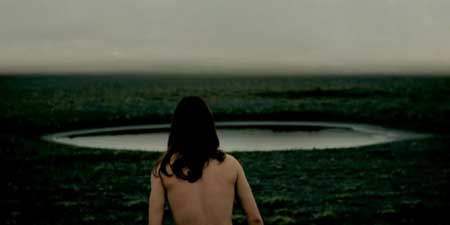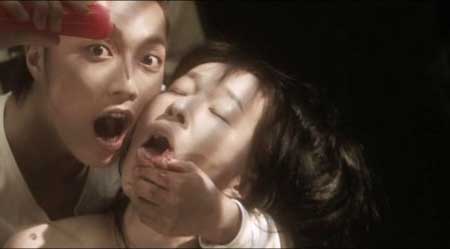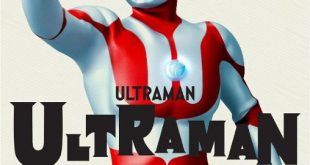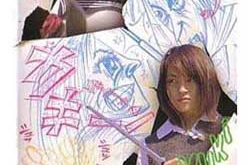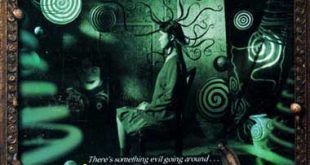Rampo Noir is an omnibus comprising of four short films based upon stories by Edogawa Rampo, Japan’s foremost proponent of the erotic grotesque or ero-guro genre and founder of the Japan Mystery Writers’ Club: Mars Canal (Kasei no Unga) directed by Suguru Takeuchi, Mirror Hell (Kagami Jigoku) directed by Akio Jissoji, Caterpillar (Imomushi) directed by Hisayasu Sato (director of one of the most interesting Japanese horror films, Naked Blood) and Atsushi Kaneko’s Crawling Bugs (Mushi). Connecting the four segments is the presence of actor and singer Tadanobu Asano, as protagonist, spectator and antagonist, whose androgyny is particular suitable to Rampo’s delirious dreams of gender switching, confusion and subversion of conventional patriarchal norms around gender and sexual identity through a ménage of the grotesque bodies and dismembered limbs, with a soupcon of S/M eroticism.
REVIEW:
While overt similarities between the writings of Edogawa Rampo – the penname of Hirai Taro – and those of the American gothic writer, Edgar Allan Poe, are foregrounded in the choice of Hirai to take a nom de plume that paid homage to the later, Rampo’s work is significantly more disturbing than that of his more famous forbearer. In Rampo Noir, we have humans being reduced to the pure sensory world of insects (Caterpillar), or a mass of oozing cellular tissue (Mirror Hell), and/or works of art (Caterpillar, Crawling Bugs). Together with this carnivalesque transformation of the human body, sadomasochist imagery is used to redefine the gendered norms– most clearly seen in Mars Canal – and subvert the boundaries between violator and victim (Caterpillar). Indeed, what is questioned repeatedly throughout Rampo Noir is the presence of an objective and irrefutable reality
Canal of Mars with which the anthology opens, is only eight minutes long, and sets the tone for the subsequent shorts with its interrogation of identity, gender and sexuality and the inability of vision to authenticate ‘reality’. Here we are invited into the subconscious of an unknown man (Asano Tadanobu), as scenes of a violent sexual encounter play out, intercut with frame images of the man, naked and alone on ‘Mars’, which is identifiable by the water filled crater by which he stands and then later slumps. For most of the eight running time, there is no sound – not just no dialogue, but no music or ambient sound either. This use of silence functions to increase the power of the images, especially those of sexual violence and creates a surreal dream-like state, from which the spectator along with the unnamed man, is only woken out of by the presence of a dissonance which gets louder and louder as the man emerges from his dream. While it seems at first that what are being offered is a typical Japanese fantasy of male potency and female passivity that is found in so many offerings in the problematic rape fantasy genre. However, this reality is subverted when the man suddenly wakes up and we are offered another version of events. In this version the boundaries between the man and the woman are blurred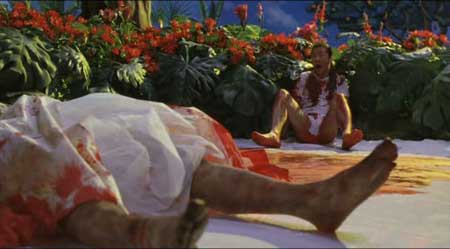
suggesting that while this may be a male fantasy, it is not one of subjugation, but rather articulates a desire to be the Other, in other words to transgress and to transform one’s gender and sexual identity.
Just as gender isn’t fixed, neither is vision which should function to affix gender categories based around the presence/absence of the penis/phallus. In Mirror Hell, vision is a sight of trauma as mirrors show the viewer an image of disease rather than beauty, and mysteriously cause the death of all who look in them. Here Asano plays Kogoro Akechi, a famed detective (who first appeared in fiction in 1925 and is one of Rampo’s most well-known characters), whose skills are called on by the Police to try and solve a string of strange deaths, which seem to have nothing in common, with the exception that all the victim are female and are all found with their features totally destroyed. In a sense Mirror Hell is to self-aware to be as entertaining as the other three films with every scene taking place in mirrored spaces, and considerably less attention paid on the resolution of the narrative enigma. Just as the antagonist, Toru (Hiroki Narimiya), who makes the mirrors, is obsessed with vision, we become prey to watching how scenes are set up and our attention is split between the action and its reflection. While I suspect that this is the very point of Mirror Hell, I found its over-stylization, staged scenes and skewed shots chosen for obvious intellectual and aesthetic purposes off-putting although I can appreciate their purpose.
The final two films are, however, much more entertaining especially from a WTF is going on perspective. In Caterpillar, a wife tends to her disabled husband after he purportedly lost all his limbs in the war. But like the other films nothing is quite what it seems and the beautiful face of the woman hides sadistic tendencies, and the over possessive nature of her love for her husband. Unlike in Mirror Hell, where shot choices and overly staged scenes detract from the narrative, here shots focalized through both the human caterpillar and a hidden watcher (scopophilia or pleasure in looking is a key theme in Rampo’s work), add to the sense of pervasive dread and horror. While Detective Akechi appears in it, he functions merely as a framing device in order to introduce the audience to one of his most devious opponent – ‘The Man with 20 Faces’.
Like Caterpillar, Crawling Bugs involves the intersection between the human and the insect worlds, except whereas in the former becoming-insect is to be desired, in the later insects are an object of profound fear. Here Asano plays an unnamed chauffer, whose germaphobia leads him to break out in painful rashes when he comes into contact with anyone. Fascinated and fixated by a beautiful actress that he takes from the theatre to her home one night, the unassuming chauffeur transforms into fully fledged stalker. The most visually stunning of all three, Atsushi utilizes a saturated canvass to paint this disturbing tale of obsession, desire, decay and death. And as with the other films here, the ending is nothing if not ambiguous. Reality, identity, gender are after all as we are continually told, a matter of perspective or as it is put in the film “Life is what is reflected in the mirror. It is neither real or unreal.”
Rampo Noir is a welcome addition to the ghost saturated J-horror universe. The sonic soundscape which accompanies the strong visual language of the films ranges from complete silence, traditional Japanese music, Jazz and Opera, gives the viewer a sense of the time in which Rampo was writing, a period of rapid transformation and modernisation, while undermining any sense of a fracture between present and past by juxtaposing the traditional and the modern to construct an uncanny canvas situated for our times. For a fan of J-horror and/or the grotesque, Rampo Noir is required viewing.
 Horror News | HNN Official Site | Horror Movies,Trailers, Reviews
Horror News | HNN Official Site | Horror Movies,Trailers, Reviews

